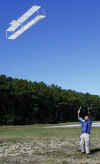 n
the early summer of 1899, Wilbur Wright stood in his bicycle shop in
Dayton, Ohio, idly twisting a small cardboard box. With his thumbs and
index fingers, he squeezed two diagonal corners on one end of the box and
the two opposite corners on the other end. When he did this, the box
twisted. In his mind's eye, Wilbur saw the top and bottom of the box as
the wings of a biplane. n
the early summer of 1899, Wilbur Wright stood in his bicycle shop in
Dayton, Ohio, idly twisting a small cardboard box. With his thumbs and
index fingers, he squeezed two diagonal corners on one end of the box and
the two opposite corners on the other end. When he did this, the box
twisted. In his mind's eye, Wilbur saw the top and bottom of the box as
the wings of a biplane.
By using cords or wires to pull the corners together, one end of each
wing would turn up while the other turned down. Both ends of the wings
would move at the same time, changing their angle of attack in opposite
directions. The end the turned up (and had a higher angle of attack) would
generate more lift, while the end that turned down (with a lower angle of
attack) would have less lift. The end of the wing with more lift would
rise while the other fell. This system could be used to balance and
control the plane, making it roll right or left.
Wilbur talked the idea over with his brother Orville, and the two
designed an experiment to test it. They built a biplane "box"
kite with wings 5 to 6 feet long and 13 to 15 inches wide. The wings
where held 13 to 15 inches apart by several struts, and all the parts were
hinged so they could move.
A small tail was attached to the back middle strut. The Wrights
controlled the kite from the ground with four strings. One end of each
string was tied to one end of the front outboard struts. The other ends
were tied to the ends of two sticks. By angling the sticks in opposite
directions while the kite was flying, the Wright brothers could
"warp" the wings and cause the kite to bank right and left. By
angling the sticks in the same direction, they could raise or lower the
tail, making the kite climb or dive.
Over the next few months, the Wrights built and flew several
"scientific" kites, perfecting their control system. In 1900,
they used this system on a man-carrying glider for the first time. Before
they risked their own necks, they flew the glider as a kite, controlling
it from the ground.
These scientific kites were hung about the bicycle shop until
1905, when the Wright brothers had finally developed a practical powered
airplane. They decided to clean house, and took the kites outside to burn.
Most were destroyed, but they gave several to some neighbor kids who
happened by.
|
Click on a
photo or drawing to enlarge it.

Wilbur found that the inner tube box took on a
helical twist when he squeezed the corners. To repeat this experiment for
yourself, click HERE.

Wilbur sketched this picture of his 1899 kite,
showing how it was controlled.

The Wright brothers continue to perform kite
experiments for many years. They even kited their gliders to measure lift
and drag.
|
Building and Flying the Kite
The 1899 Wright Kite is a fairly simple project
to make, if you'd like to build one. It's also an excellent project for
young people, if you happen to have a class or a group of kids who
are interested in aviation. Not only does it teach them the basics of
aircraft design and control, it gets them hands on with one of the most
important events in aviation history.
To get you going, we've posted the plans and instructions here:
- Resurrecting the
Wright Kite gives you the historical facts behind this
flying machine and describes how we resurrected the plans from the scant
details available. This, by the way, was the Wright Brothers Aeroplane
Company's first adventure in aviation
archaeology.
- The 1899 Wright Kite
Plans provide detailed engineering drawings for the kite
that you can download and print out as large as you'd like. We also
provide some tips to help with construction.
- Flying the Wright Kite
is a flight school for flying this machine. It can be tricky!
|

This is our replica of the 1899 Wright kite. You can
see more details in our Virtual Hangar Click Here. |
You're Invited!
If you build a replica of Wright Kite, why don't you bright it to Kitty
Hawk and fly it with us on the Centennial Anniversary of Controlled
Flight. One hundred years ago on October 8, 1902, the Wright
brothers flew their 1902 glider for the first time with 3-axis controls --
roll, pitch, and yaw. This is widely considered to be their most important
contribution to aviation, and it was the culmination of the experiments
they began in 1899 with this kite. For more details click HERE. |

Flying the 1899 Wright Kite at Kitty Hawk. |

